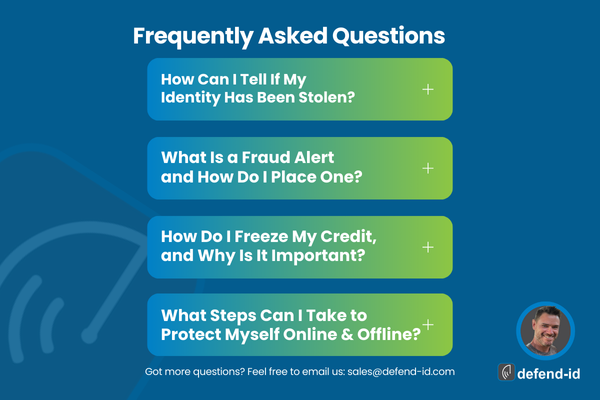Securing your personal data with reliable identity theft protection strategies is essential for financial and personal security. Many consumers are actively looking for answers on how to prevent identity fraud, what measures to take when suspicious activity occurs, and how to recover quickly if their identity is compromised. Below, we present a detailed FAQ addressing the most frequently asked questions we’ve been receiving recently.
1. How Can I Tell If My Identity Has Been Stolen?
Effective identity theft protection begins with recognizing the warning signs. Look for:
- Unexpected Accounts: Check your credit report for accounts you did not open.
- Unusual Inquiries: Monitor your credit for unauthorized inquiries.
- Missing Mail: A sudden absence of bills or statements may indicate a change of address by a fraudster.
- Unexplained Charges: Review bank and credit card statements for unfamiliar transactions.
Regular monitoring of your credit report—whether annually or quarterly—helps you catch any early signs of identity fraud.
2. What Is a Fraud Alert and How Do I Place One?
A fraud alert is a critical tool in identity theft protection. It signals to creditors that extra verification is needed before opening new credit in your name. Here’s how to place one:
- Contact a Credit Bureau: Call any of the major bureaus (Equifax, Experian, or TransUnion) to request a fraud alert.
- Automatic Notification: The bureau will inform the other agencies on your behalf.
- Alert Duration: A standard fraud alert lasts 90 days; extended alerts are available for confirmed victims.
This extra verification step helps prevent unauthorized credit applications.
3. How Do I Freeze My Credit, and Why Is It Important?
A credit freeze (also known as a security freeze) is a highly effective measure for identity theft protection. It prevents new creditors from accessing your credit report, thus stopping identity thieves from opening accounts in your name. Key points include:
- How to Initiate: Contact Equifax, Experian, and TransUnion to freeze your credit. This service is free for U.S. residents.
- Temporary Lift: If you plan to apply for new credit, you must temporarily lift the freeze.
- Benefits: Keeping your credit report inaccessible reduces the risk of new account fraud significantly.
Implementing a credit freeze is a proactive step that adds substantial security to your financial identity.
4. What Steps Can I Take to Protect My Identity Both Online and Offline?
Combining both digital and physical strategies is essential for comprehensive identity theft protection:
- Online Protection:
- Use strong, unique passwords for every account.
- Enable multi-factor authentication (MFA) on all accounts.
- Stay alert for phishing emails and texts; avoid clicking on suspicious links.
- Keep devices and software updated with the latest security patches.
- Offline Protection:
- Shred any documents containing sensitive personal information.
- Secure your mail with a locked mailbox.
- Regularly review bank and credit card statements for unauthorized transactions.
These practices together form a robust defense against identity theft.
5. What Should I Do If I Discover I’m a Victim of Identity Theft?
If you suspect your identity has been compromised, act swiftly:
- File a Report: Immediately contact your local law enforcement to file a police report.
- Notify Financial Institutions: Inform your bank and credit card companies to halt further unauthorized transactions.
- Place Fraud Alerts or Freeze Credit: Contact the major credit bureaus to request a fraud alert or initiate a credit freeze.
- Use Recovery Resources: Visit IdentityTheft.gov for a detailed recovery plan and further guidance.
- Document Everything: Keep records of all communications and actions taken for evidence and follow-up.
Quick and decisive action can minimize the financial and personal damage from identity theft.
6. How Do Scammers Steal My Personal Information?
Scammers employ a variety of methods to bypass identity theft protection measures:
- Phishing Attacks: Fraudulent emails or texts trick you into sharing sensitive information.
- Data Breaches: Hackers may infiltrate companies to steal large amounts of personal data.
- Physical Theft: Thieves may steal your mail, wallet, or electronic devices containing personal identifiers.
- Social Engineering: Tactics that exploit human psychology to extract personal details.
Understanding these methods is crucial to adopting effective measures to secure your personal information.
7. What’s the Difference Between Identity Theft and Financial Fraud?
While often confused, identity theft and financial fraud differ in scope:
- Financial Fraud: Involves unauthorized use of your existing accounts (such as fraudulent credit card charges).
- Identity Theft: Involves the broader misuse of your personal data—for example, using your Social Security number to open new accounts or file fraudulent tax returns.
The consequences of identity theft are typically more extensive and long-lasting, which is why comprehensive identity theft protection measures are vital.
Conclusion
Implementing robust identity theft protection strategies is crucial for securing your personal information and financial well-being. By recognizing the warning signs, using fraud alerts and credit freezes, and combining both online and offline security measures, you can significantly reduce your risk of identity fraud.
For further guidance, explore related topics on our website such as our Credit Monitoring Guide and our Fraud Prevention Tips. We also invite you to subscribe to our newsletter for the latest updates on protecting your identity.
Stay proactive—subscribe to our newsletter and follow us on social media for continuous updates on identity theft protection tips, news, and best practices.
Identity theft protection-related articles:
- The Comprehensive Guide to Combating Identity Theft in Educational Institutions
- defend-id Blog
- http://www.defend-id.com
